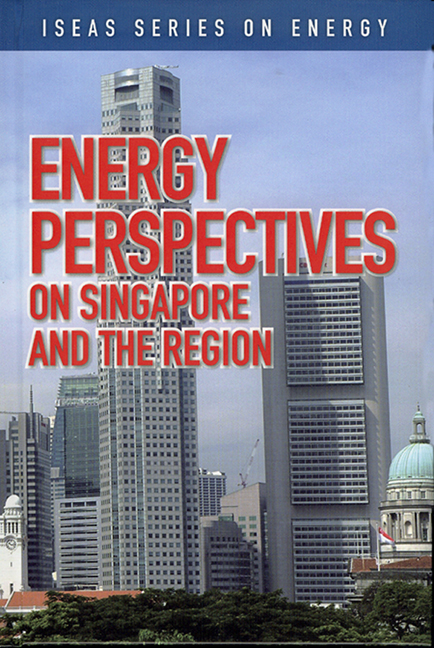Book contents
- Frontmatter
- Contents
- Foreword
- Preface
- The Contributors
- 1 Overview of Singapore's Energy Situation
- 2 Singapore's Changing Landscapes in Energy
- 3 Singapore's Role as a Key Oil Trading Centre in Asia
- 4 Large-Scale Solar PV Power Generation in Urban High-Rise Buildings in Singapore
- 5 The High-Carbon Story of Urban Development in Southeast Asia
- 6 Renewable Energy and the Environment: Technology and Economic Perspectives
- 7 Delivering Results in a Booming Rig Market
- 8 The Success Story of Rig Building in Singapore
- 9 The Singapore Oil Situation
- 10 Singapore Petroleum Company: Adding Value to the Singapore Oil Industry
- 11 Oil Storage: The Singapore Story
- REGIONAL and INTERNATIONAL
- 12 The Outlook for Energy: A View to 2030
- 13 India's Energy Situation: The Need to Secure Energy Resources in an Increasingly Competitive Environment
- 14 The Implications and Impacts of China's Oil Demand on the Asia Pacific
- 15 Energy Security Cooperation in Asia: An ASEAN-SCO Energy Partnership?
- 16 China's Energy Security: Geo-politics versus Interdependence
- 17 The Strategic Challenges for the United States and China in Global Energy Supply
- 18 China's Coal: Curse or Blessing
- 19 Japan's New Energy Strategy
- 20 Who Wins in the Asian Scramble for Oil?
- 21 New Horizons for Liquefied Natural Gas (LNG) East of Suez
- 22 Bio and Synthetic Fuels: An Alternative for Sustainable Mobility
- 23 Price Discovery for Middle East Refined Product Exports: A Natural Role for Dubai
- 24 The Outlook for Gas in Southeast Asia
- 25 Sakhalin-2 Project, a New Energy Source for the Asia Pacific: History in the Making
- Index
20 - Who Wins in the Asian Scramble for Oil?
from REGIONAL and INTERNATIONAL
Published online by Cambridge University Press: 21 October 2015
- Frontmatter
- Contents
- Foreword
- Preface
- The Contributors
- 1 Overview of Singapore's Energy Situation
- 2 Singapore's Changing Landscapes in Energy
- 3 Singapore's Role as a Key Oil Trading Centre in Asia
- 4 Large-Scale Solar PV Power Generation in Urban High-Rise Buildings in Singapore
- 5 The High-Carbon Story of Urban Development in Southeast Asia
- 6 Renewable Energy and the Environment: Technology and Economic Perspectives
- 7 Delivering Results in a Booming Rig Market
- 8 The Success Story of Rig Building in Singapore
- 9 The Singapore Oil Situation
- 10 Singapore Petroleum Company: Adding Value to the Singapore Oil Industry
- 11 Oil Storage: The Singapore Story
- REGIONAL and INTERNATIONAL
- 12 The Outlook for Energy: A View to 2030
- 13 India's Energy Situation: The Need to Secure Energy Resources in an Increasingly Competitive Environment
- 14 The Implications and Impacts of China's Oil Demand on the Asia Pacific
- 15 Energy Security Cooperation in Asia: An ASEAN-SCO Energy Partnership?
- 16 China's Energy Security: Geo-politics versus Interdependence
- 17 The Strategic Challenges for the United States and China in Global Energy Supply
- 18 China's Coal: Curse or Blessing
- 19 Japan's New Energy Strategy
- 20 Who Wins in the Asian Scramble for Oil?
- 21 New Horizons for Liquefied Natural Gas (LNG) East of Suez
- 22 Bio and Synthetic Fuels: An Alternative for Sustainable Mobility
- 23 Price Discovery for Middle East Refined Product Exports: A Natural Role for Dubai
- 24 The Outlook for Gas in Southeast Asia
- 25 Sakhalin-2 Project, a New Energy Source for the Asia Pacific: History in the Making
- Index
Summary
INTRODUCTION
This chapter will be in three parts. First it reviews the oil demand trends in Asia, it then presents a brief sketch of the various strategies of Asian Oil Importing Countries, and lastly, discusses who the seven lucky winners in the Asian scramble for oil are.
HIGH OIL PRICES
Figure 20.1 shows a graph of the historical trend of oil prices. It shows that oil prices have breached all historical highs, above levels reached during the 2003 Iraq War or the 1991 Gulf War.
Oil prices have been hovering at the US$70 level since then. As to why oil prices are so high, there are up to two dozen different reasons every day that one could cite as reasons why oil prices are currently at such historical levels.
The demand for oil has very much been linked to GDP growth. There is a strong correlation between economic growth with demand for oil. It is a cyclical pattern, and the robust GDP growth in 2004 had led to an unexpectedly strong surge in oil demand, which has reached twenty-year highs. The actual increase in demand in 2004 was 2.6 million barrels a day in additional requirements, and more than half of this incremental demand is attributed to China and other emerging Asian countries. The increase in demand continued in 2005/06, although it has slowed down a little bit.
Among the top ten oil consuming nations, there are four Asian countries: China, Japan, India, and South Korea. China is the only Asian country among the top ten oil producers, ranking sixth. In terms of imports, five out of top ten oil importers are Asian countries: Japan, China, South Korea, India, Taiwan.
CHINA
What brought the increase in oil demand? First, consumption of oil from China has increased because of their thirst for cars. Traffic congestion in China is getting worse. Vehicle sales reached 5.6 million in 2005, up 13 per cent.
- Type
- Chapter
- Information
- Energy Perspectives on Singapore and the Region , pp. 249 - 265Publisher: ISEAS–Yusof Ishak InstitutePrint publication year: 2007

